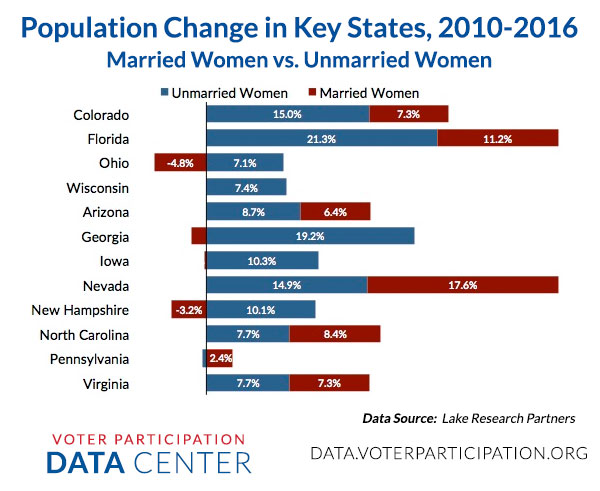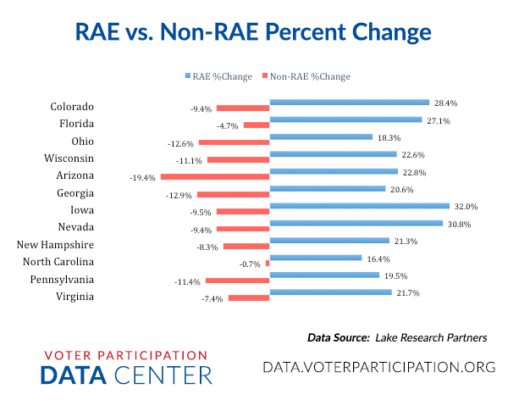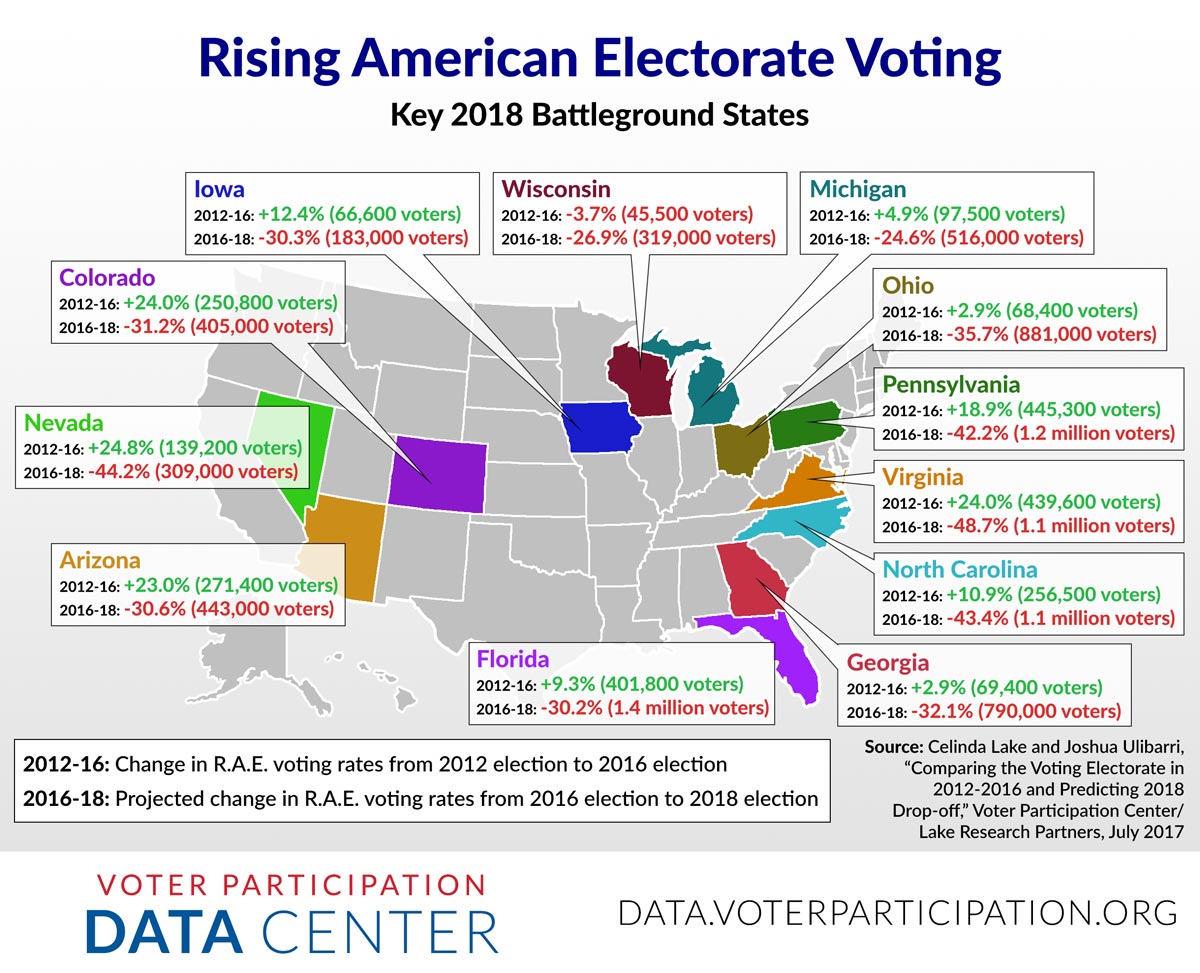Comparing the Voting Electorate in 2012-2016 and Predicting 2018 Drop-Off
As part of our ongoing efforts to understand the voting patterns of the Rising American Electorate, we’ve worked with Lake Research Partners to produce this report, which catalogues the changes in voting turnout for the Rising American Electorate between 2012 and 2016 – and makes projections for voter drop-off in 2018.
The projections are sobering and troubling to everyone who cares about increasing participation in our great democracy. Our prediction is that 40 million Americans who voted in 2016 won’t cast a ballot in the 2018 midterms — and to make matters worse, 2/3 of those drop-off voters will be members of the Rising American Electorate. The RAE dropoff is projected to be particularly pronounced in key 2018 battleground states, such as Arizona, Nevada, Florida, and Ohio:
Add in the effects of ongoing vote suppression efforts and the implication is clear: Democracy is facing a headwind in 2018. We need to double down on voter registration, mobilization and turnout efforts, and fighting for voting rights in order to make sure that every American has the opportunity to raise their voice at the ballot box.
Downloads
Unmarried Women: Growing in Numbers and the Power to Decide 2016 Elections
There are more than 58 million single women eligible to vote this November. For the first time ever, there are more single women than married women eligible to vote, and their numbers continue to grow nationally and in key states. And as the new poll of nine battleground states conducted for Women’s Voices Women Vote Action Fund shows, single women could determine the outcome of the presidential election and U.S. Senate races down-ballot.

Chart: Rising American Electorate vs. Non-RAE Percent Change
This chart showing the growth of the Rising American Electorate – unmarried women, people of color, and Millennials – in key states between 2010 and 2016 demonstrates quite clearly how broadly and quickly the face of America is changing.

All information was provided by Lake Research Partners.
The Rising American Electorate on Super Tuesday
On Tuesday, March 1, 2016, the largest number of states will hold primaries or caucuses. Super Tuesday states this year include: Alabama, Alaska (Republican caucuses), Arkansas, Colorado (caucuses), Georgia, Massachusetts, Minnesota (caucuses), Oklahoma, Tennessee, Texas, Vermont, Virginia, and Wyoming (Republican caucuses).
In most presidential years, Super Tuesday is a turning point, serving as a major indicator of who the nominees will be from each party. It is the biggest single-day opportunity for presidential candidates to receive delegates.
What’s at stake? In all, 595 Republican delegates—a little less than half of the 1,237 delegates required to win the GOP nomination—will be available on Super Tuesday. On the Democratic side, about 1,004 delegates will be available on March 1, out of the 2,383 delegates a candidate will need to win the nomination.
The participation of the Rising American Electorate (RAE)—unmarried women, people of color and millennials—has the potential to dramatically affect outcomes in several states where they make up a large percentage of eligible voters:
- In Texas, GOP candidate Senator Ted Cruz’s home state, the RAE makes up 66% of eligible voters, but as of November 2014 only 52% of the RAE were registered to vote. 46% of the eligible voters in Texas are people of color; 29% are 35 or younger.
- In Georgia, 62% of the eligible voters are either unmarried women, people of color or millennials. 59% of them are registered to vote. 39% of the state’s eligible voters are people of color.
- In Alaska, 61% of the state’s eligible voters are members of the RAE; 62% of the RAE are registered to vote. People of color make up 38% of the state’s eligible voters.
- In Alabama, the RAE makes up 56% of the eligible voters; 62% of the RAE are registered to vote. 30% of eligible voters in Alabama are people of color.
- In Virginia, 56% of eligible voters are RAE members; 59% of the RAE are registered to vote. 30% of eligible voters are people of color.
Unmarried women make up at least a quarter of the eligible voters in these Super Tuesday states: Alabama (27%), Arkansas (25%), Georgia (27%), Massachusetts (27%), Minnesota (25%), Oklahoma (25%), Tennessee (27%), Texas (26%), and Vermont (25%).
Learn more about unmarried women in the Super Tuesday states:
|
Alabama Alaska Arkansas Colorado |
Georgia Massachusetts Minnesota |
Oklahoma Tennessee Texas |
Vermont Virginia Wyoming |
New Data for the New Year
Here’s an updated look at the median earnings, health insurance coverage and poverty rates for unmarried women in 16 states. These profiles provide detailed demographic and economic portraits of the growing number of increasingly politically-powerful single women.
| California Colorado Florida Illinois |
Iowa Kentucky Missouri Nevada |
New Hampshire New York North Carolina Ohio |
Pennsylvania Texas Virginia Wisconsin |
Unmarried Women: The Key to Unlocking the New American Electorate
An astonishing number of single women aren’t yet registered to vote. If we help even a small percentage more of unmarried women register and vote, we’d likely see different results up and down the ballot in key 2016 states.
(Click on a state name in the table to view our demographic profile of unmarried women for that state.)
| State | Unmarried Women | % of Vote-Eligible Population | Registered to Vote | Not Registered to Vote |
| Colorado | 830,224 | 22% | 546,725 (66%) | 283,499 (34%) |
| Florida | 3,637,949 | 26% | 2,184,986 (60%) | 1,452,963 (40%) |
| Iowa | 524,096 | 23% | 325,929 (62%) | 198,167 (38%) |
| Missouri | 1,010,097 | 23% | 665,390 (66%) | 344,707 (34%) |
| Nevada | 482,278 | 26% | 266,875 (55%) | 215,404 (45%) |
| New Hampshire | 239,332 | 24% | 146,705 (61%) | 92,627 (39%) |
| North Carolina | 1,803,826 | 26% | 1,147,794 (64%) | 656,032 (36%) |
| Ohio | 2,171,933 | 26% | 1,341,439 (62%) | 830,495 (38%) |
| Pennsylvania | 2,296,628 | 24% | 1,404,064 (61%) | 892,563 (39%) |
| Virginia | 1,399,995 | 24% | 831,891 (59%) | 568,104 (41%) |
| Wisconsin | 1,007,304 | 24% | 637,094 (63%) | 370,210 (37%) |
Data Source: Current Population Survey: Voting and Registration Supplement, 2014. U.S. Department of Commerce, Bureau of the Census.
Statistical Profile of Unmarried Women: Virginia
Our research team has compiled available data from the US Census Bureau, the Bureau of Labor Statistics, and other sources to put together this statistical profile of the demographic and economic circumstances facing unmarried women in the Commonwealth of Virginia.
Report updated May 2017


